In the realm of culinary pursuits, the choice between modern small-batch cooking appliances and traditional cooking appliances often hinges on considerations of convenience, efficiency, versatility, and personal preference. Here, we delve into a comparative analysis of these two categories to elucidate their respective strengths, weaknesses, and suitability for different culinary contexts.
Size and space considerations:
Modern Small Batch Cooking Appliances:
- Advantages: Compact dimensions make them ideal for smaller kitchens, apartments, or dormitories where space is at a premium.
- Limitations: May have reduced capacity compared to traditional appliances, necessitating multiple batches for larger meals.
Traditional Cooking Appliances:
- Advantages: They typically offer larger capacities, making them well-suited for cooking meals for families or gatherings.
- Limitations: Require more kitchen space and storage area, which may be impractical for individuals or smaller households.
Efficiency and Convenience:
Modern Small Batch Cooking Appliances:
- Advantages: Designed for efficiency, with features such as quick heating, precise temperature control, and automated cooking functions.
- Limitations: may have limited capabilities compared to their traditional counterparts, particularly for specialized cooking techniques or larger-scale recipes.
Traditional Cooking Appliances:
- Advantages: Offer a wide range of cooking functions and settings, allowing for versatility in meal preparation.
- Limitations: They often require longer preheating times, manual monitoring, and cleanup, leading to potential inefficiencies in time and effort.
Versatility and adaptability:
Modern Small Batch Cooking Appliances:
- Advantages: Tailored functionalities cater to specific culinary needs, such as single-serve blending, compact baking, or precision cooking.
- Limitations: may lack the versatility of traditional appliances for multi-purpose cooking tasks or handling larger quantities of ingredients.
Traditional Cooking Appliances:
- Advantages: Versatile and adaptable, capable of performing a wide range of cooking methods, from baking and roasting to grilling and frying.
- Limitations: May be less optimized for smaller-scale cooking or individual portions, leading to potential waste or overproduction.
Sustainability and Waste Reduction:
Modern Small Batch Cooking Appliances:
- Advantages: Facilitate portion control and minimize food waste by preparing precisely sized meals tailored to individual appetites.
- Limitations: It may consume energy and resources inefficiently if not used judiciously or if relying on disposable accessories.
Traditional Cooking Appliances:
- Advantages: It can be used to cook larger quantities of food for batch cooking or meal prep, reducing the need for frequent cooking sessions.
- Limitations: This may contribute to overproduction and food waste if not managed effectively, especially when cooking for smaller households or individuals.
In summary, the choice between modern small-batch and traditional cooking appliances ultimately depends on individual preferences, lifestyle factors, and culinary priorities. While modern small-batch cooking appliances excel in space efficiency, convenience, and portion control, traditional cooking appliances offer versatility, adaptability, and capacity suited for larger-scale meal preparation. By understanding the strengths and limitations of each category, individuals can make informed decisions to create a culinary environme




